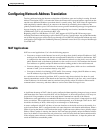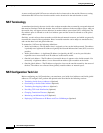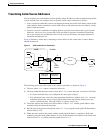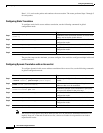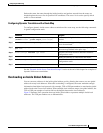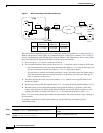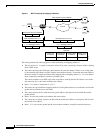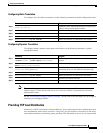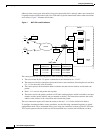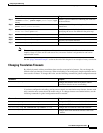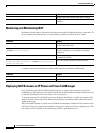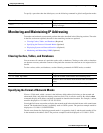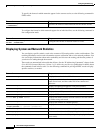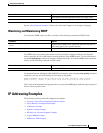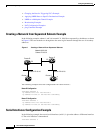
Configuring IP Addressing
Configuring Network Address Translation
IPC-43
Cisco IOS IP Configuration Guide
Configuring Static Translation
To configure static SA address translation, use the following commands in global configuration mode:
Configuring Dynamic Translation
To configure dynamic outside source address translation, use the following commands in global
configuration mode:
Note The access list must permit only those addresses that are to be translated. (Remember that there is an
implicit “deny all” at the end of each access list.) An access list that is too permissive can lead to
unpredictable results.
See the “Translating Overlapping Address Example” section at the end of this chapter for an example of
translating an overlapping address.
Providing TCP Load Distribution
Another use of NAT is unrelated to Internet addresses. Your organization may have multiple hosts that
must communicate with a heavily used host. Using NAT, you can establish a virtual host on the inside
network that coordinates load sharing among real hosts. DAs that match an access list are replaced with
Command Purpose
Step 1
Router(config)# ip nat outside source static
global-ip local-ip
Establishes static translation between an outside local
address and an outside global address.
Step 2
Router(config)# interface type number
Specifies the inside interface.
Step 3
Router(config-if)# ip nat inside
Marks the interface as connected to the inside.
Step 4
Router(config)# interface type number
Specifies the outside interface.
Step 5
Router(config-if)# ip nat outside
Marks the interface as connected to the outside.
Command Purpose
Step 1
Router(config)# ip nat pool name start-ip end-ip
{netmask netmask | prefix-length prefix-length}
Defines a pool of local addresses to be allocated as
needed.
Step 2
Router(config)# access-list access-list-number
permit source [source-wildcard]
Defines a standard access list.
Step 3
Router(config)# ip nat outside source list
access-list-number pool name
Establishes dynamic outside source translation,
specifying the access list defined in the prior step.
Step 4
Router(config)# interface type number
Specifies the inside interface.
Step 5
Router(config-if)# ip nat inside
Marks the interface as connected to the inside.
Step 6
Router(config)# interface type number
Specifies the outside interface.
Step 7
Router(config-if)# ip nat outside
Marks the interface as connected to the outside.



